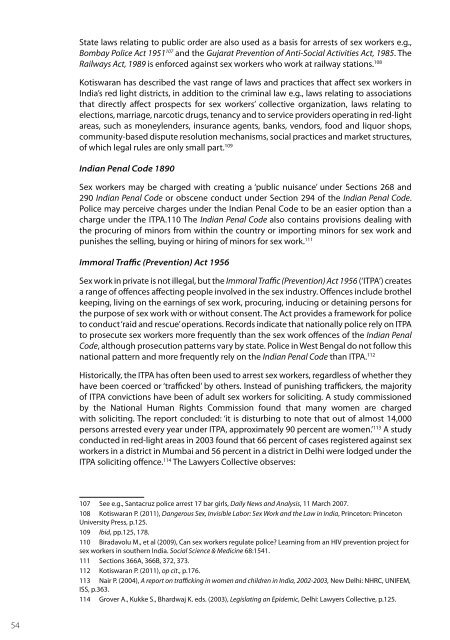SEX WORK AND THE LAW - HIV/AIDS Data Hub
SEX WORK AND THE LAW - HIV/AIDS Data Hub
SEX WORK AND THE LAW - HIV/AIDS Data Hub
Create successful ePaper yourself
Turn your PDF publications into a flip-book with our unique Google optimized e-Paper software.
State laws relating to public order are also used as a basis for arrests of sex workers e.g.,<br />
Bombay Police Act 1951 107 and the Gujarat Prevention of Anti-Social Activities Act, 1985. The<br />
Railways Act, 1989 is enforced against sex workers who work at railway stations. 108<br />
Kotiswaran has described the vast range of laws and practices that affect sex workers in<br />
India’s red light districts, in addition to the criminal law e.g., laws relating to associations<br />
that directly affect prospects for sex workers’ collective organization, laws relating to<br />
elections, marriage, narcotic drugs, tenancy and to service providers operating in red-light<br />
areas, such as moneylenders, insurance agents, banks, vendors, food and liquor shops,<br />
community-based dispute resolution mechanisms, social practices and market structures,<br />
of which legal rules are only small part. 109<br />
Indian Penal Code 1890<br />
Sex workers may be charged with creating a ‘public nuisance’ under Sections 268 and<br />
290 Indian Penal Code or obscene conduct under Section 294 of the Indian Penal Code.<br />
Police may perceive charges under the Indian Penal Code to be an easier option than a<br />
charge under the ITPA.110 The Indian Penal Code also contains provisions dealing with<br />
the procuring of minors from within the country or importing minors for sex work and<br />
punishes the selling, buying or hiring of minors for sex work. 111<br />
Immoral Traffic (Prevention) Act 1956<br />
Sex work in private is not illegal, but the Immoral Traffic (Prevention) Act 1956 (‘ITPA’) creates<br />
a range of offences affecting people involved in the sex industry. Offences include brothel<br />
keeping, living on the earnings of sex work, procuring, inducing or detaining persons for<br />
the purpose of sex work with or without consent. The Act provides a framework for police<br />
to conduct ‘raid and rescue’ operations. Records indicate that nationally police rely on ITPA<br />
to prosecute sex workers more frequently than the sex work offences of the Indian Penal<br />
Code, although prosecution patterns vary by state. Police in West Bengal do not follow this<br />
national pattern and more frequently rely on the Indian Penal Code than ITPA. 112<br />
Historically, the ITPA has often been used to arrest sex workers, regardless of whether they<br />
have been coerced or ‘trafficked’ by others. Instead of punishing traffickers, the majority<br />
of ITPA convictions have been of adult sex workers for soliciting. A study commissioned<br />
by the National Human Rights Commission found that many women are charged<br />
with soliciting. The report concluded: ‘it is disturbing to note that out of almost 14,000<br />
persons arrested every year under ITPA, approximately 90 percent are women.’ 113 A study<br />
conducted in red-light areas in 2003 found that 66 percent of cases registered against sex<br />
workers in a district in Mumbai and 56 percent in a district in Delhi were lodged under the<br />
ITPA soliciting offence. 114 The Lawyers Collective observes:<br />
107 See e.g., Santacruz police arrest 17 bar girls, Daily News and Analysis, 11 March 2007.<br />
108 Kotiswaran P. (2011), Dangerous Sex, Invisible Labor: Sex Work and the Law in India, Princeton: Princeton<br />
University Press, p.125.<br />
109 Ibid, pp.125, 178.<br />
110 Biradavolu M., et al (2009), Can sex workers regulate police? Learning from an <strong>HIV</strong> prevention project for<br />
sex workers in southern India. Social Science & Medicine 68:1541.<br />
111 Sections 366A, 366B, 372, 373.<br />
112 Kotiswaran P. (2011), op cit., p.176.<br />
113 Nair P. (2004), A report on trafficking in women and children in India, 2002-2003, New Delhi: NHRC, UNIFEM,<br />
ISS, p.363.<br />
114 Grover A., Kukke S., Bhardwaj K. eds. (2003), Legislating an Epidemic, Delhi: Lawyers Collective, p.125.<br />
54
















